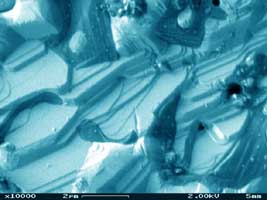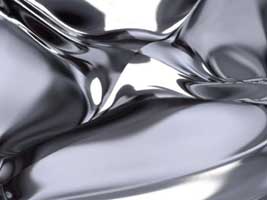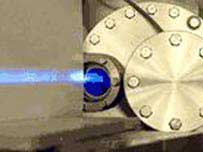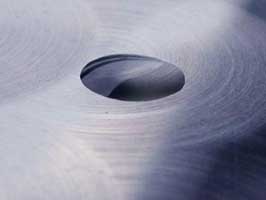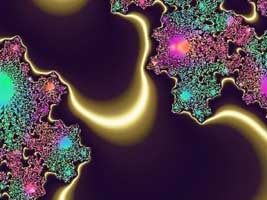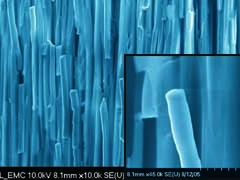|
My work at Harvard focused on studies of newly discovered ordered surface phases in otherwise relatively simple liquids. This work included development of
experimental x-ray scattering techniques utilizing recently available
third-generation synchrotron sources.
My thesis research can be highlighted by two recent results: a discovery of
surface-frozen phase in liquid AuSi [Shpyrko et al., Science 313, 77 (2006)] and surface-demixing in liquid BiSn (Shpyrko et al., Phys. Rev. Lett. 95, 106103 (2005)]
Other notable (favorite?) results include discovery of surface layering in liquid
potassium [Shpyrko et al., Phys. Rev. B 67, 115405 (2003)] as well as experimental evidence that liquid water is not layered [Shpyrko et al., Phys. Rev. B 69 245423, (2004)]. These findings resolve long-standing disputes as to whether the layering is due to metallic nature of interactions or high value of surface tension (screened-Coulomb interactions in metals appear to be an important factor) and whether the dielectric liquids are layered (they are not).
My current work at Argonne's Nanocenter and University of Chicago is best summarized by two directions:
1. Investigation of materials characterized by complex quenched
disorder, such as spin (SDW) and charge density wave (CDW) domains in
itinerant antiferromagnets.
2. Capillarity and self-assembly in nanoporous materials.
Physics of Liquid Surfaces:
|
Surface-Induced
Layering:
Surfaces
and interfaces define the boundaries of thermodynamic phases and often
exhibit properties that are strikingly different from those of the
bulk. Most of the surface
science studies focus on studies of solids, but surfaces of even most basic
liquids have not been thoroughly investigated.
What is the nature of interface between liquid and vapor in simplest monatomic liquids? The answer depends on nature of atomic interactions in the two phases.
|
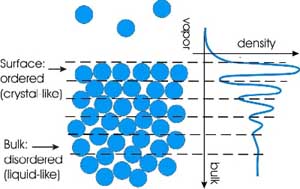
|
|
While atomic and
small-molecule liquids are generally unstructured (randomly packed) in the bulk, we have
discovered that at the surface atoms of metallic liquids are stratified into series of
quasi-crystalline layers - so-called "surface layering" phenomena, which
has been a topic of theoretical and computer simulation studies for
several decades but has not been observed experimentally until recently.
All of the metallic liquids studied thus far exhibit surface layering,
while surfaces of non-metallic liquids such as water are not layered.
Recently we have established that the layering is caused primarily by
electronic properties of the metallic liquids through interactions of
quantum Fermi electron gas and classical ionic liquid, rather than
thermodynamic parameters such as surface tension.
[top]
|
|

|
Thermal Surface Fluctuations:
Unlike
solid surfaces, free liquid surfaces are not static and
are prone to thermally excited surface fluctuations, or capillary waves.
Even in absence of external vibrations, thermally excited fluctuations can significantly complicate direct determination of
atomic structure at the surface. We have developed theoretical and
computational models that allow us to separate the intrinsic atomic structure from roughening caused by surface dynamics.
[top]
|
|
Segregation,
Wetting in Binary Mixtures:
A more subtle question is the surface structure of binary fluids, such as
mixture of two monatomic liquids. The formation of surface phase strongly
depends on the interactions
between two types of atoms.
Near-surface region composition is defined primarily by the competition of
surface energetics and bulk thermodynamics of
the two elemental phases. |
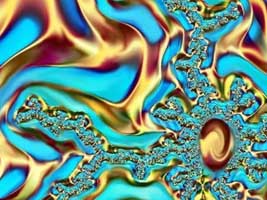
|
|
We
have recently demonstrated that in miscible systems (such as eutectic BiSn
alloy) effects of Gibbs adsorption, previously thought to be limited only to surface
monolayer extends further into the bulk - to at least 3
near-surface atomic layers. The observed
atomic-scale demixing indicates that atomic interactions in the
near-surface region are significantly enhanced over nearly-perfect
solution behavior in the bulk. In immiscible mixtures (such as monotectic GaBi) surface
segregation can lead to emergence of nanoscale surface wetting films with strongly
temperature-dependent thickness.
[top]
|
|
Surface Freezing:
Recently we discovered an unusual surface
freezing phenomenon in eutectic AuSi alloy - a formation of well-defined 2D crystalline surface
phase with long-range in-plane ordering, as well as anomalously enhanced
surface-normal "layering". While in-plane surface ordering has been
previously seen in quasi-2D confined systems (Langmuir and Gibbs monolayers), or for long-chain molecular liquids
(alkanes and liquid crystals) where anisotropy
of the molecules controls ordering, this is the first observation of
surface freezing in simple homogeneous system.
[top]
|
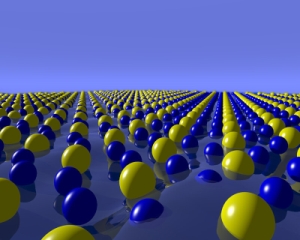 |
|
 |
Solid-Liquid
Interfaces:
Despite
a great number of theoretical research describing
physics of solid-melt interfaces, very few existing experemintal techniques can be applied to studies
these "deeply buried" interfaces. High-energy x-ray scattering tools can solve this problem and
provide unique look at structure, dynamics and reactions at liquid-solid
buried interfaces. One of the interesting questions is existence of
hard-wall induced ordering in liquid phase, similar to surface layering in metallic liquids.
[top]
|
|
Reactions
at surfaces and interfaces:
Most
chemical reactions such as oxidation originate at surfaces and proceed
into the bulk. While at solid surfaces the nucleation
and growth of oxides begins primarily at defects and impurities, liquid
surfaces are defect-free and can be made atomically clean, therefore
providing a perfect system to study intrinsic surface oxidation that occurs in complete absence
of pre-existing nucleation centers. Our recent studies of oxidation of
liquid metals have demonstrated existence of oxidation exposure
threshold, which provides a
unique view of kinetics of
nucleation and growth. |
 |
|
Oxidation of defect-free surfaces often results surface crystalline phases previously not observed in the bulk form.
[top]
|
Quantum Dynamics and Magnetism:


|
Spin (Charge,
Strain) Density Waves:
Coupling between spin, charge and lattice degrees of freedom
can often produce interesting physics, best examplified by non-conventional high-temperature superconductors and magnetoresistant manganites.
Elemental chromium is a simple body-cubic centered metal that exhibits a complex magnetic phase diagram with spin density wave ground state, pseudogap and quantum critical behavior that is usually found only in more complex transition metal oxides, and therefore can provide some important insight into behavior of strongly correlated systems.
[top]
|
|
|
|
Magnetic Domain dynamics with "Quantum Speckle":
Once
in magnetically ordered phase, a material typically consists of a wide
variety of magnetic domains defined by different orientations of
magnetization (spin). Detailed behavior of these magnetic domains is
currently not well understood: while domains walls are often pinned by
impurities or defects within the crystal, some domain walls can move around due to thermal fluctuations. At low temperatures thermal
fluctuations are "frozen out", domain walls would be expected to become immobile according to classical physics.
|
 |
| |
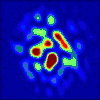
|
However, even at absolute zero temperature domain walls can be seen "tunnel-hopping" across hilly energetic landscape to another low-energy configuration - a quantum-mechanical effect that arises from Heisenberg uncertainty principle. Observations of quantum-tunnelling
rates in simple magnetic systems provides a direct measure of strength of quantum fluctuations. Dynamics of magnetic domain walls can be studied with coherent scattering techniques, in particular X-ray Photon Correlation Spectroscopy - an extension of visible light "speckle" spectroscopy to x-ray regime.
[top]
|
|
|
|

|
Quantum Critical Behavior of Itinerant Magnets:
Conventionally, phase transitions occur as a function of temperature - boiling and freezing of water are everyday examples. In the last decade attention has focused on quantum phase transitions, which occur at absolute zero temperature, with composition, magnetic field or density as the driving parameter between two ground states of the system.
During quantum phase transition disorder is imposed by quantum fluctuations
arising from Heisenberg uncertainty principle, rather than thermal fluctuations.
|
The regime where contributions of quantum fluctuations are significant is called "quantum critical" and behavior of materials in this regime is currently not known.
Understanding behavior of simple metals near quantum critical point,
should shed some light on physics of exotic
systems such as high-Tc superconductors, magnetic insulators and two-dimensional electron gases.
[top]
|
Nanoconfined
Materials:
|
Various properties of macroscopic materials are primarily defined by the behavior
within the bulk. As the sizes of objects approach nanometer scale,
behavior of surface and interface becomes increasingly dominant over bulk
terms. In addition to studying detailed structure and other properties of
materials in nanoscale confinement, we also aim to learn how to manipulate
various phases of matter into the confinement matrix. |
 |
|
  |
Recent experiments include manipulation of nanoparticles confined within
nanoporous alimina samples through capillary
condensation of solvent, studies of discontinuous filling transition and
structure of metallic quantum wire arrays that are just a few nm
thick.
[top]
|
|


